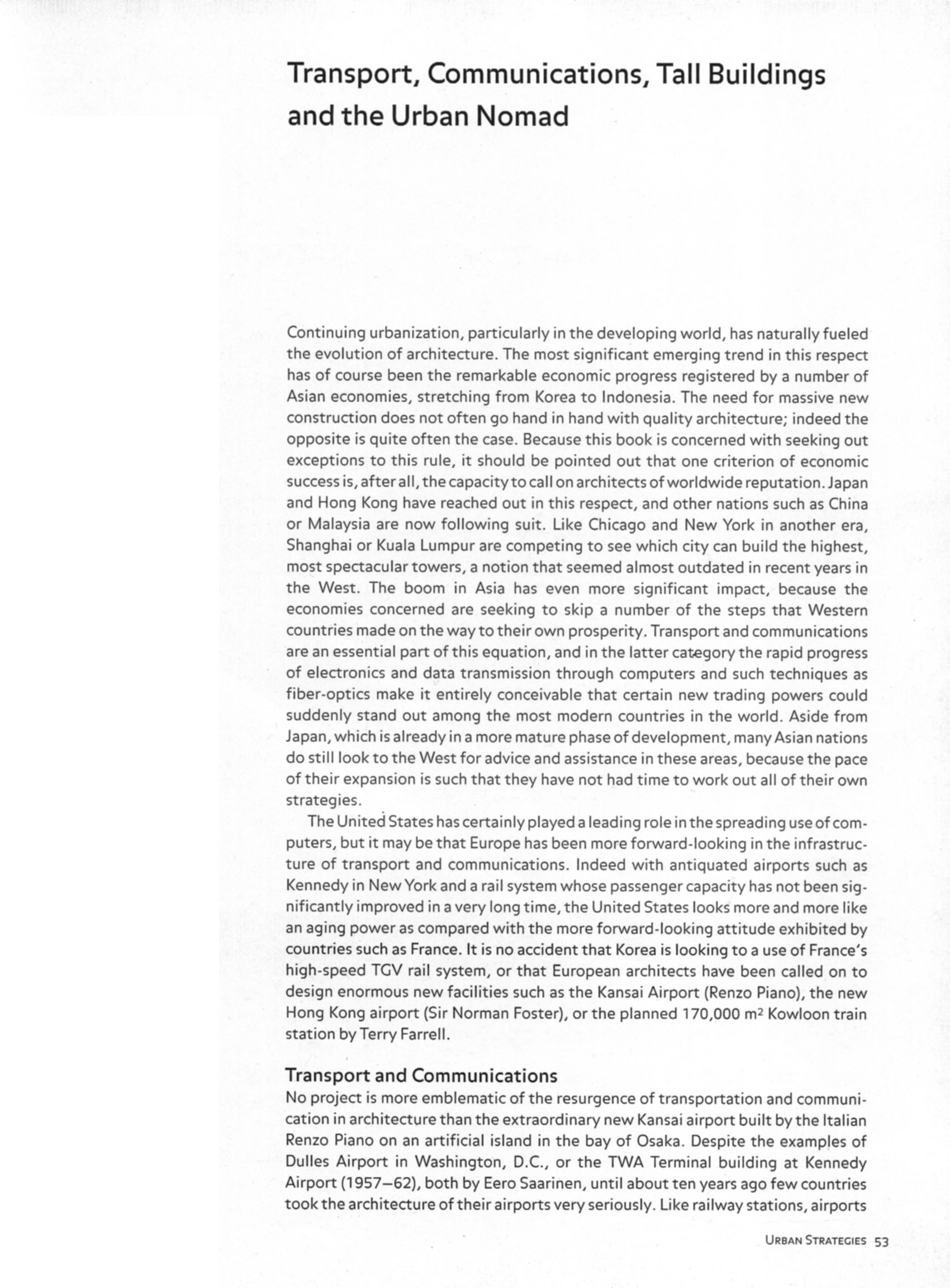New Forms Taschen 048

Transport, Communications, Tali Buildings and the Urban Nomad
Continuing urbanization, particularly in the developing world, has naturally fueled the evolution of architecture. The most significant emerging trend in this respect has of course been the remarkable economic progress registered by a number of Asian economies, stretching from Korea to Indonesia. The need for massive new construction does not often go hand in hand with quality architecture; indeed the opposite is quite often the case. Because this book is concerned with seeking out exceptions to this rule, it should be pointed out that one criterion of economic success is, after all, the capacity to cali on architects of worldwide reputation. Japan and Hong Kong have reached out in this respect, and other nations such as China or Malaysia are now following suit. Like Chicago and New York in another era, Shanghai or Kuala Lumpur are competing to see which city can build the highest, most spectacular towers, a notion that seemed almost outdated in recent years in the West. The boom in Asia has even morę significant impact, because the economies concerned are seeking to skip a number of the steps that Western countries madę on the way to their own prosperity. Transport and Communications are an essential part of this equation, and in the latter category the rapid progress of electronics and data transmission through computers and such techniques as fiber-optics make it entirely conceivable that certain new trading powers could suddenly stand out among the most modern countries in the world. Aside from Japan, which is already in a morę maturę phase of development, many Asian nations do still look to the West for advice and assistance in these areas, because the pace of their expansion is such that they have not had time to work out all of their own strateg ies.
The United States has certainly played a leading role in the spreading use of computers, but it may be that Europę has been morę forward-looking in the infrastruc-ture of transport and Communications. Indeed with antiquated airports such as Kennedy in New York and a raił system whose passenger capacity has not been sig-nificantly improved in a very long time, the United States looks morę and morę like an aging power as compared with the morę forward-looking attitude exhibited by countries such as France. It is no accident that Korea is looking to a use of France's high-speed TGV raił system, or that European architects have been called on to design enormous new facilities such as the Kansai Airport (Renzo Piano), the new Hong Kong airport (Sir Norman Foster), or the planned 170,000 m2 Kowloon train station by Terry Farrell.
Transport and Communications
No project is morę emblematic of the resurgence of transportation and communi-cation in architecture than the extraordinary new Kansai airport built by the Italian Renzo Piano on an artificial island in the bay of Osaka. Despite the examples of Dulles Airport in Washington, D.C., or the TWA Terminal building at Kennedy Airport (1957-62), both by Eero Saarinen, until about ten years ago few countries took the architecture of their airports very seriously. Like railway stations, airports
Urban Strategies 53
Wyszukiwarka
Podobne podstrony:
71714 New Forms Taschen 159 Right Frank Stella "Watson and the Shark” Aluminum on iron base Ove
53518 New Forms Taschen 003 Contents 7 Introduction New Geometries 51 Urban Stratecies Transport, Co
New Forms Taschen 063 ive to local discourse, and is also forward looking."14 Simply put, not e
New Forms Taschen 156 Pages 166/167 Schweitzer BIM The Monument JoshuaTree, California. 1987-90
New Forms Taschen 183 UH Steven Holi D.E. Shaw and Company Office New York. New York. 1991-92 The re
69218 New Forms Taschen 104 built, Ando seeks to make the visitor aware that he is entering a sacred
więcej podobnych podstron